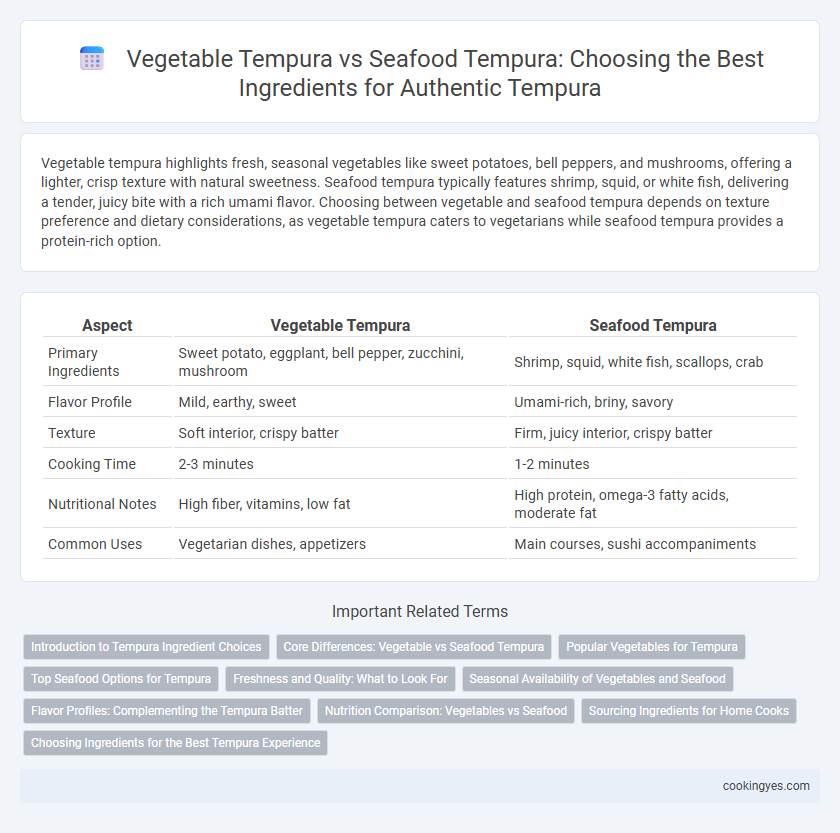Vegetable tempura highlights fresh, seasonal vegetables like sweet potatoes, bell peppers, and mushrooms, offering a lighter, crisp texture with natural sweetness. Seafood tempura typically features shrimp, squid, or white fish, delivering a tender, juicy bite with a rich umami flavor. Choosing between vegetable and seafood tempura depends on texture preference and dietary considerations, as vegetable tempura caters to vegetarians while seafood tempura provides a protein-rich option.
Table of Comparison
| Aspect | Vegetable Tempura | Seafood Tempura |
|---|---|---|
| Primary Ingredients | Sweet potato, eggplant, bell pepper, zucchini, mushroom | Shrimp, squid, white fish, scallops, crab |
| Flavor Profile | Mild, earthy, sweet | Umami-rich, briny, savory |
| Texture | Soft interior, crispy batter | Firm, juicy interior, crispy batter |
| Cooking Time | 2-3 minutes | 1-2 minutes |
| Nutritional Notes | High fiber, vitamins, low fat | High protein, omega-3 fatty acids, moderate fat |
| Common Uses | Vegetarian dishes, appetizers | Main courses, sushi accompaniments |
Introduction to Tempura Ingredient Choices
Vegetable tempura offers a vibrant variety of seasonal produce such as sweet potatoes, bell peppers, and green beans, providing a light and crispy texture ideal for those seeking a vegetarian option. Seafood tempura features shrimp, squid, and white fish, delivering a rich umami flavor that enhances the dish's traditional Japanese essence. Selecting between vegetable and seafood tempura ingredients depends on desired taste profiles and dietary preferences, each contributing unique nutritional benefits and culinary experiences.
Core Differences: Vegetable vs Seafood Tempura
Vegetable tempura features ingredients like sweet potatoes, carrots, and bell peppers, offering a lighter, crisp texture with a naturally sweet flavor profile. Seafood tempura primarily includes shrimp, squid, and white fish, delivering a richer taste with a tender, succulent interior encased in a crispy batter. The core difference lies in ingredient moisture and flavor intensity, where vegetables provide a mild and fibrous bite, while seafood contributes briny, savory complexity.
Popular Vegetables for Tempura
Popular vegetables for tempura include sweet potatoes, bell peppers, green beans, and shiitake mushrooms, prized for their crisp texture and natural sweetness after frying. These vegetables absorb the light, airy batter well, providing a satisfying contrast to the crispy exterior. Seafood tempura, by comparison, typically features shrimp or white fish, which offer a tender bite and subtle oceanic flavor that complements the vegetable variety on the tempura platter.
Top Seafood Options for Tempura
Top seafood options for tempura include shrimp, squid, and white fish such as cod or flounder, prized for their tender texture and ability to absorb the light, crispy batter. Shellfish like scallops and crab add a sweet, briny flavor that complements the delicate tempura batter without overpowering it. These seafood varieties provide a flavorful contrast to vegetable tempura, making them a preferred choice for those seeking a rich, umami-packed tempura experience.
Freshness and Quality: What to Look For
When selecting ingredients for vegetable tempura, prioritize crisp, firm vegetables like sweet potatoes, green beans, or bell peppers that show no signs of wilting or discoloration, ensuring optimal freshness and texture. For seafood tempura, choose fresh fish or shellfish with a mild, oceanic aroma and translucent flesh, avoiding any fishy or off-putting smells that indicate spoilage. High-quality ingredients directly impact the lightness and flavor of the tempura batter, making freshness essential for both vegetable and seafood varieties.
Seasonal Availability of Vegetables and Seafood
Seasonal availability significantly influences ingredient selection for vegetable tempura and seafood tempura, with spring featuring fresh asparagus and bamboo shoots, while summer offers eggplant and shiso leaves ideal for tempura batter. Seafood tempura ingredients vary by season, such as sweet shrimp and whitebait in spring, transitioning to crab and anago eel in autumn, ensuring optimal freshness and flavor. Selecting ingredients based on seasonal peaks enhances the texture and taste, maintaining the authenticity and quality of tempura dishes.
Flavor Profiles: Complementing the Tempura Batter
Vegetable tempura features ingredients like sweet potato, pumpkin, and bell pepper, offering natural sweetness and earthy notes that balance the light, crispy tempura batter. Seafood tempura, commonly made with shrimp or white fish, delivers a delicate umami flavor and subtle brininess that enhances the batter's subtlety without overpowering it. Choosing between vegetable and seafood tempura depends on the desired flavor harmony, with vegetables providing a sweeter, milder profile and seafood contributing savory depth.
Nutrition Comparison: Vegetables vs Seafood
Vegetable tempura offers rich dietary fiber, vitamins like A and C, and antioxidants supporting digestive health and immune function. Seafood tempura provides high-quality protein, omega-3 fatty acids, and essential minerals such as zinc and iodine, promoting cardiovascular and brain health. Choosing between vegetable and seafood tempura depends on nutritional goals, with vegetables enhancing fiber intake and seafood supplying vital nutrients for metabolic and neural functions.
Sourcing Ingredients for Home Cooks
Home cooks sourcing ingredients for vegetable tempura often prioritize fresh, firm vegetables like sweet potatoes, bell peppers, and green beans that maintain crispness when fried. Seafood tempura requires selecting high-quality, fresh seafood such as shrimp, squid, or white fish with a firm texture and minimal odor to ensure optimal flavor and texture. Choosing ingredients with consistent freshness from local markets or trusted suppliers enhances the overall tempura experience and helps achieve authentic taste and texture.
Choosing Ingredients for the Best Tempura Experience
Selecting the freshest vegetables like sweet potato, eggplant, and shiso leaves ensures a light, crispy vegetable tempura with vibrant flavors. For seafood tempura, prioritize firm, fresh options such as shrimp, scallops, and white fish to achieve a delicate, juicy interior wrapped in a golden, airy batter. Balancing moisture content and texture in each ingredient is key to creating the perfect tempura that maintains crispness without oiliness.
Vegetable Tempura vs Seafood Tempura for ingredient selection Infographic

 cookingyes.com
cookingyes.com